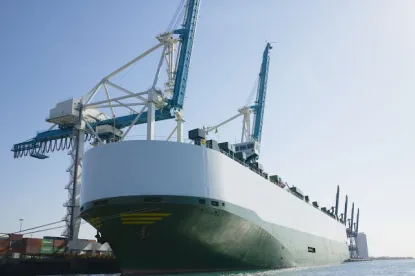The Fifth Circuit Court of Appeals recently upheld the granting of summary judgment in favor of a defendant vessel owner on the grounds that the longshoreman working aboard the defendant's vessel could not establish that the defendant breached a duty owed to him. In doing so, the Fifth Circuit provided a succinct review of the duties owed by a vessel owner under §905(b) of the Longshore and Harbor Workers' Compensation Act in the context of dangerous work being performed in hazardous conditions. The case is Abston v. Jungerhaus Mar. Servs. GMBH & Co. KG, C.A. No. 15-41381, 2016 WL 6574085, at *1 (5th Cir. Nov. 4, 2016).
The plaintiff, Joseph Abston (plaintiff), was a longshoreman working aboard the defendant's vessel and engaged in loading operations when he slipped and fell from a "flat rack" cargo shipping container. A flat rack consists of a floor structure with a high loading capacity and two end walls, which may be either fixed or collapsible. The end walls allow for cargo to be securely attached and for flat racks to be stacked on top of one another. There was heavy rainfall on the day of the plaintiff's accident, and operations had been suspended roughly 30 minutes before the accident because it was raining so hard it "obscured the longshoremen's [sic] vision."
The plaintiff was working as a lasher, which required him to climb to the top of each flat rack and unhook it from the crane that loaded it onto the deck. Instead of using a ladder, the plaintiff "shimmied up the side of [the flat rack]" by receiving a "boost" from another longshoreman and climbing up the flat rack's hinges. The plaintiff was not wearing any fall-safety equipment. While holding on to a hinge on the flat rack, the plaintiff slipped and fell 10 feet to the vessel's top deck and then fell another 15 feet to the bottom deck. The plaintiff suffered significant injuries and brought suit against the defendant vessel owner under §905 of the LHWCA.
As the Fifth Circuit observed, a vessel owner owes three duties to a longshoreman under §905(b) of the LHWCA:
-
a turnover duty;
-
a duty to exercise reasonable care in the areas of the ship under the active control of the vessel; and
-
a duty to intervene.
These are the so-called Scindia duties, established by the United States Supreme Court in Scindia Steam Nav. Co., Ltd. v. Santos, 451 U.S. 156 (1981).
The plaintiff alleged that the defendant vessel owner breached two of these duties: the so-called active control duty and the duty to intervene. More specifically, the plaintiff alleged that the defendant vessel owner failed to replace the "safety expansion" after cargo unloading operations ceased and that it failed to intervene and replace the safety expansion, which left a hazardous work condition for the longshoremen and stevedore to work around. The safety expansion was a "series of two-and-a-half-foot-tall pipes linked together by rope," which was routinely removed during cargo operations.
The Fifth Circuit noted that the active control duty is broader than the duty to intervene, and, as such, a defendant vessel owner must exercise reasonable care to prevent injuries to longshoremen in areas that remain under the "active control of the vessel." In other words, when a defendant vessel owner retains active control over a certain area of the vessel during cargo operations or otherwise, it maintains responsibility for the safety of longshoremen and other non-employees/Jones Act seamen working aboard the vessel in that area. The defendant vessel owner, however, can (and often does) relinquish control over an area to a stevedore so that it can conduct loading or unloading operations. When a vessel owner relinquishes control over an area (such as a cargo hold), the stevedore then becomes responsible for remedying any hazard in that area. In addressing this duty, courts focus on certain factual determinations, including whether the area in question is within the contractor's/stevedore's work area, whether the area has been turned over to the contractor/stevedore, and whether the vessel owner controls the methods and operative details of the contractor's/stevedore's work.
The plaintiff argued that the vessel owner was exercising active control over the loading operations because it did not permit him to move, remove, or replace the safety expansion. The Fifth Circuit rejected this argument and noted that there was no evidence that the vessel's crew controlled any aspect of the stevedore's or longshoreman's work. Further, the Fifth Circuit held that even though the vessel owner allegedly prohibited the moving, removing, or replacement of the safety expansion, this prohibition was not enough to establish that the vessel owner maintained active control over the area in which the plaintiff was working.
The Fifth Circuit then addressed the plaintiff's argument regarding the duty to intervene. "[A] vessel has a duty to intervene when it has actual knowledge of a dangerous condition and actual knowledge that the stevedore, in the exercise of obviously improvident judgment, has failed to remedy it." To establish a breach of the duty to intervene, a plaintiff must establish
-
the vessel owner had actual knowledge of a defect;
-
the vessel owner had actual knowledge that a defect posed an unreasonable risk of harm; and
-
the vessel owner had "actual knowledge that it could not rely on the stevedore to protect its employees and that if unremedied the condition posed a substantial risk of injury."
In finding that the vessel owner did not breach its duty to intervene, the Fifth Circuit first noted that the plaintiff exercised "obviously improvident judgment" by climbing onto the flat rack without a safety harness or ladder. Further, the vessel owner had removed the safety expansion as a matter of course during loading operations, and the plaintiff never complained about the missing safety expansion.
Most importantly, though, the Fifth Circuit held that the defendant vessel owner could not have reasonably anticipated that the plaintiff would climb the flat rack without a safety harness immediately after a driving rainstorm. The Fifth Circuit relied upon prior rulings in which it held that even if a risk exists, a vessel owner was entitled to rely upon a stevedore's and/or longshoreman's own judgment that a dangerous condition was safe enough to perform the necessary work. According to the Fifth Circuit, a vessel owner is required to intervene only when a stevedore's or longshoreman's judgment "in continuing to work in the face of danger is 'obviously improvident." The Fifth Circuit held that there was no evidence that the vessel owner knew that the missing safety expansion created an unreasonable risk of harm or that the vessel owner was aware that the plaintiff would climb the flat rack without a safety harness. Therefore, no duty to intervene existed.
The Fifth Circuit's ruling, though not precedential, nonetheless provides vessel owners with additional authority to rely upon when defending against a §905(b) claim. The Fifth Circuit's decisions also arguably provide a stronger argument that (1) certain work is inherently risky and (2) the so-called Scindia duties should be applied in a limited, rather than an expansive, manner.



 />i
/>i
